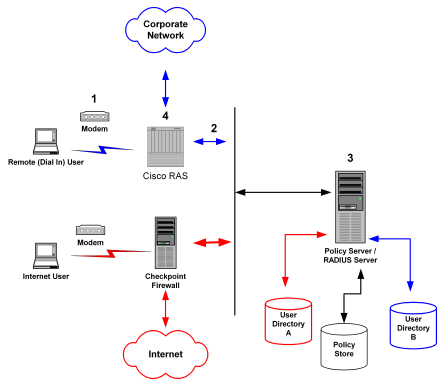The Policy Server can also be configured to authenticate users for multiple NAS devices when the user information for each device is located in separate user directories. The NAS devices can be of different vendor types.
There are several advantages to this configuration:
An example of a heterogeneous configuration that uses two user directories is illustrated in the following graphic:

Unlike the topology described in the previous section, this Policy Server uses two user directories to authenticate the users. User information for the Cisco RAS users is stored in User Directory A. User information for the Checkpoint firewall is stored in User Directory B. The Policy Server can authenticate users using both of these directories.
By dividing the configuration into two policy domains, the need for realm hints is eliminated. Each RADIUS Agent exists in a separate policy domain and is bound to only one realm.
The process of authentication when two user directories are used is as follows:
The RAS notifies the Policy Server that the session has begun and when the session ends.
When the Internet user attempts to dial into the Internet Service Provider by using the Checkpoint Firewall, this same process of authentication occurs. However, the Policy Server evaluates the Internet user's authentication information against a different user directory.
| Copyright © 2010 CA. All rights reserved. | Email CA about this topic |